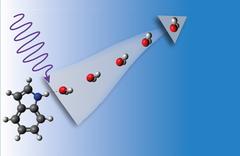URL: https://www.desy.de/news/news_search/index_eng.html
Breadcrumb Navigation
DESY News: How biomolecules react to UV light
News
News from the DESY research centre
How biomolecules react to UV light
A sophisticated experiment provides new insights into the ultrafast reaction of biomolecules when they are hit by energetic ultraviolet light in their natural environment. The team of DESY scientist Jochen Küpper recorded the light-induced processes taking place in a small complex of two molecules that served as model system for the interactions between proteins and surrounding solvent molecules, usually water. The experiment is an important step on the way to record a “molecular movie” of such chemical reactions, as the team reports in the journal Nature Communications. That paper was selected as an Editor's Highlight by the journal. Küpper is DESY Lead Scientist for controlled molecule imaging.

When the indole-water complex is hit by energetic UV light, it begins to vibrate violently until the water detaches. Credit: Radboud University, Jolijn Onvlee
As a model system, the scientists chose the aromatic compound indole (C8H7N), which is the chromophore of the amino acid tryptophan and thus present in essentially all proteins. To investigate the interactions between proteins and their solvent surrounding, the scientists attached water to the indole molecules. However, indole can bind to several water molecules. To single out compounds of exactly one indole and one water molecule, the team used an electrostatic deflector that disperses the compounds in different directions depending on the number of water molecules attached.
The scientists shot pulses from a UV laser at the indole-water aggregates. These aggregates absorb the UV light, after which complex dynamics take place on the femtosecond (quadrillionths of a second) and picosecond (trillionths of a second) timescales. A second laser was used to record the resulting reaction products on an imaging detector. By changing the delay between the two lasers, snapshots of the ultrafast dynamics could be made at different stages, revealing the course of events. “When the UV light strikes the complex, excited state dynamics take place first, and after electronic relaxation the system starts vibrating vigorously,” explains Küpper. “The indole molecule is feeling totally hot.” Finally, it detaches from the water.
“Thanks to the combination of the electrostatic deflector and time-resolved imaging, we could now disentangle these ultrafast processes taking place in the complex,” says Küpper. “Ultimately, we would like to record an atomic-resolution ‘molecular movie’ in which we really see the path of the water leaving the indole molecule. The present research brings us an important step closer to reaching this goal.”
The work was done in the context of and partly funded by the Cluster of Excellence “CUI: Advanced Imaging of Matter” at Universität Hamburg.
Reference:
Ultrafast light-induced dynamics in the microsolvated biomolecular indole chromophore with water; Jolijn Onvlee, Sebastian Trippel & Jochen Küpper; „Nature Communications“, 2022; DOI: 10.1038/s41467-022-33901-w




